The Laws of Retail Gravitation
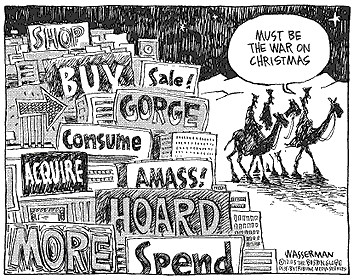 Dan Wasserman cartoon, Boston Globe.
Dan Wasserman cartoon, Boston Globe.I've stirred up some controversy on the pro-urb list (I've mentioned it here in other entries) by likening the upcoming New Urbanist trip to Bentonville to try to get Walmart to design a traditional commercial district "friendly" store to getting Nazis to design context-sensitive concentration camps.


In one of the exchanges today, I figured out why Walmart and similar stores have a different impact on the surrounding commercial district compared to department stores. While department stores expected to dominate sales in the commercial district, they didn't expect to win every customer and take all the transactions.
On the other hand, category killer big boxes and price killer big boxes like Walmart function much differently than how the department stores did. Such stores don't build up the entire business district. They are more comparable to corn bred genetically to withstand frequent applications of Roundup pesticide... nothing survives but the specially genetically bred Roundup ready corn, or the 225,000 sf. Walmart Supercenter.
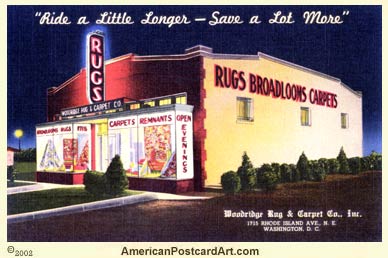 Historic postcard image, Woodridge Rug Shop, Rhode Island Ave., Washington, DC.
Historic postcard image, Woodridge Rug Shop, Rhode Island Ave., Washington, DC.Such stores attract customers and intend for their customers to spend all their money only within the store, which after they finish transacting their business, the customer leaves to return home, not to spend another dime in the adjacent commercial district.
 Reuters photograph.
Reuters photograph.A pro-urb entry by Seth Harry makes a good point about the success of commercial districts, based on "Reilly's Law of Retail Gravitation" from the ULI Shopping Center Handbook, paraphrased below:
The breaking point for the attraction between two regional concentrations of population (retail agglomerations) will be in direct proportion to the relative scale of the two entities. In other words, all other things being equal, people will tend to shop at the largest retail offering, most easily reached. This is the fundamental rationale behind the consolidation and upsizing of suburban retail formats over the last 30 years, aided and abetted by the changes in our regional road networks(fewer, bigger roads, yield fewer, bigger boxes...).
I think a corollary of the "Law of Retail Gravitation" particularly relevant to traditional neighborhood and downtown commercial districts concerns the comfort and convenience of the commercial district, especially compared to other places where customers can shop, be it an enclosed shopping mall or another traditional commercial district nearby. This relates to the "pain of change" that I have discussed as far as a customer or prospect's current shopping habits are concerned, at least in the cities? Why shop local if you have to wend your way through trash and other signs of disorder? Instead, you'll continue to shop where its comfortable, convenient, and you have a lot of shopping options.
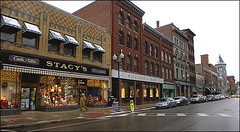 Downtown Augusta Maine. Boston Globe photo.
Downtown Augusta Maine. Boston Globe photo.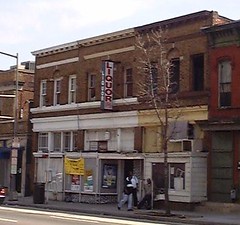 415 H Street NE. Washington, DC. Photo courtesy of Michael Berman.
415 H Street NE. Washington, DC. Photo courtesy of Michael Berman. 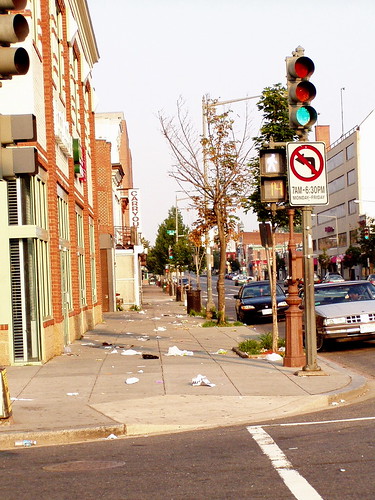 Trash on H Street is not a competitive advantage compared to Georgetown, Dupont Circle, or an enclosed mall. Photo by Elise Bernard.
Trash on H Street is not a competitive advantage compared to Georgetown, Dupont Circle, or an enclosed mall. Photo by Elise Bernard.
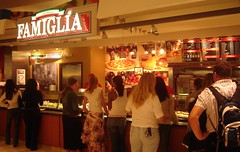 Famous Famiglia, Food Court, Tysons Corner Center, Virginia.
Famous Famiglia, Food Court, Tysons Corner Center, Virginia.
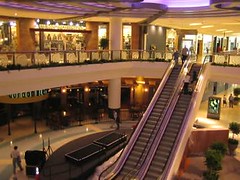 Tysons Corner Center, Virginia.
Tysons Corner Center, Virginia.



0 Comments:
Post a Comment
<< Home